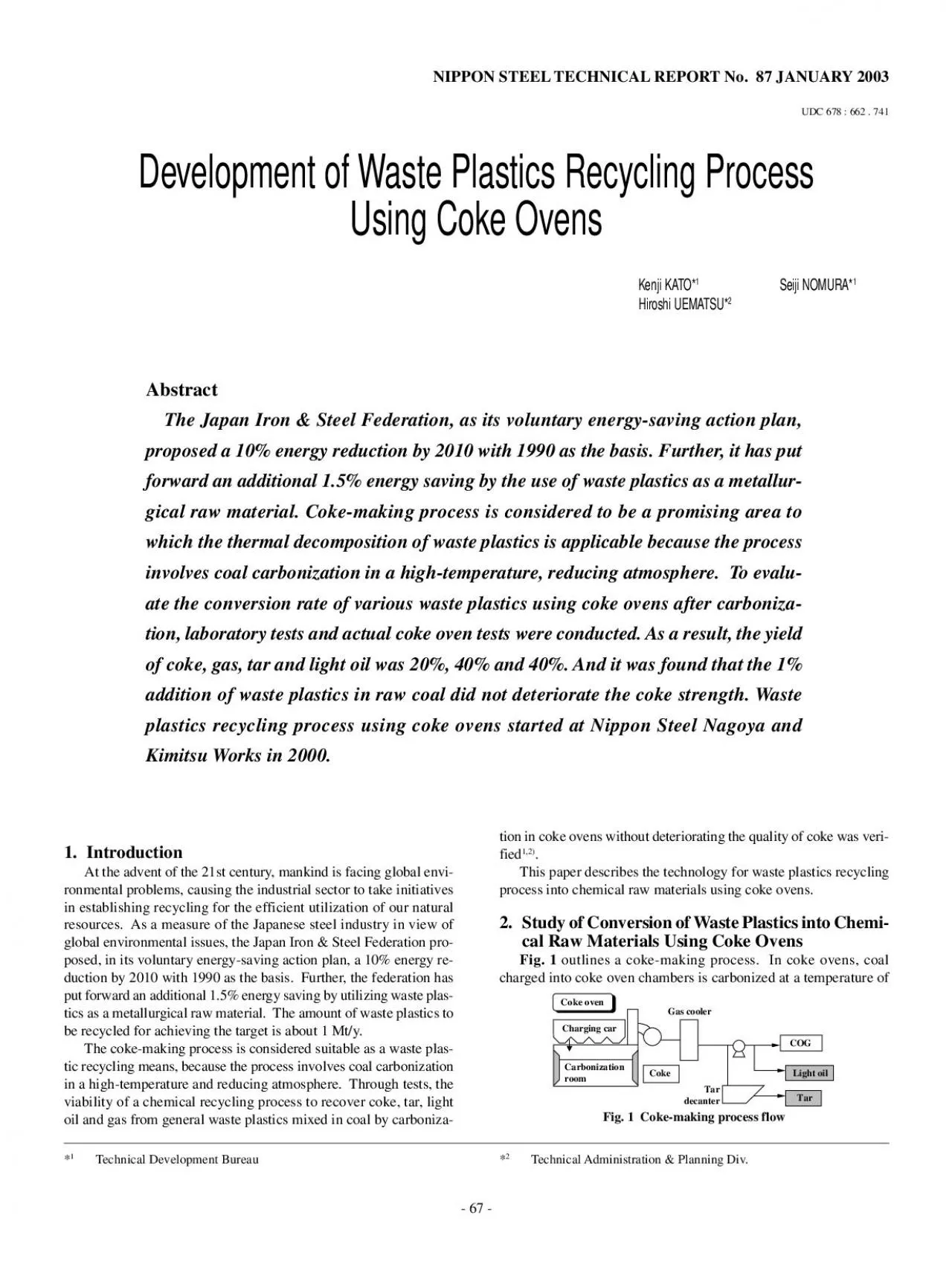

1IntroductionAt the advent of the 21st century mankind is facing global enviin establishing recycling for the efficient utilization of our naturalresources As a measure of the Japanese steel indu ID: 940793
Download Pdf The PPT/PDF document "NIPPON STEEL TECHNICAL REPORT No 87 JAN..." is the property of its rightful owner. Permission is granted to download and print the materials on this web site for personal, non-commercial use only, and to display it on your personal computer provided you do not modify the materials and that you retain all copyright notices contained in the materials. By downloading content from our website, you accept the terms of this agreement.
NIPPON STEEL TECHNICAL REPORT No. 87 JANUARY 2003Development of Waste Plastics Recycling ProcessKenji KATO*Hiroshi UEMATSU* 1.IntroductionAt the advent of the 21st century, mankind is facing global envi-in establishing recycling for the efficient utilization of our naturalresources. As a measure of the Japanese steel industry in view of Fig. 1 Coke-making process flowTechnical Administration & Planning Div. NIPPON STEEL TECHNICAL REPORT No. 87 JANUARY 2003 ucts, namely coke, tar, light oil and coke oven gas (COG), etc. Atthe exit from ascension pipes at the top of the ovens, ammonia liquorC or less. Then, the gas is cooled in a primary gas cooler to aboutliquor at a tar decanter.The carbonization conditions in the coke ovens are consideredsuitable for the recycling of waste plastics because charged plastics3.Test, Test Results and Discussions3.1Evaluation of Carbonization Product YieldsWe conducted a test of processing general waste of plastic con-Tables 1 and 2) using commercial coke ovens. The yields from the3.2Influence of Waste Plastic Addition on Coke QualityWe evaluated, through a test in commercial coke ovens, the cokestrength in the case that general waste plastics after a volume reduc-tion treatment is added to coal by 1 mass %. The coke strength w
asstrength after high temperature reactions. The result was that whendustry is about 50 Mt. If waste plastics are to be added to the coalcharge by 1 mass %, the waste plastics consumed will add up toabout 500,000 t/y. This corresponds to half the target processingamount for the additional 50% energy saving by the utilization ofwaste plastics in the JISFÕs voluntary energy saving action plan.added to coal in a larger amount (e.g. more than 2 mass %), coke3.3Waste Plastics Recycling Process Using Coke Ovens shows the process flow of the waste plastic recycling bythe Coke Oven from Waste Plastics to Chemical Raw MaterialsMethod. After waste plastic containers and packaging are pre-treatedmixed with blended coal, charged into coke ovens, and decomposedgas), approximately. The collected material is used as a chemicalraw material. The recovered coke is used to reduce the iron ore in atics etc., and the COG is used at a power plant, etc. as a clean energymestic Containers and Packaging Recycling Laws. Nippon Steelstarted the waste plastic recycling activities by said method in 2000.Kimitsu Works in 2000. The treatment capacity is 40,000 t/y eachTwo more plants that employ the same method started up at Muroranand Yawata Works in 2002, with a treatment capacity of 2
0,000 t/yeach. All these plants including the pre-treatment facilities and the4.Summary(1)It is possible to convert general waste plastics into coke, tar, light(2)The method is approved as a chemical recycling technology inaccordance with the Containers and Packaging Recycling Law, Table 2 Component of waste plastics Table 1 Ultimate analysis and ash content of waste plastics Power generator,chemical plantBFCOGCokeTar &light oilChemicalraw material 605856Without wasteplasticsCSR (%)Waste plasticsadded (1%)Fig. 4 Influence of waste plastics addition on CSR Fig. 5 Outline of waste plastics recycling process using coke ovens NIPPON STEEL TECHNICAL REPORT No. 87 JANUARY 2003and the plants in which the method is applied have been in com-mercial operation at Nagoya and Kimitsu Works since 2000. The(3)Further studies shall be focused on identification of problems inReferences1)Kato, K., Komaki, I., Uematsu, H., Nomura, S., Kondo, H., Shiraishi,K.,2)Kato, K., Komaki, I., Uematsu, H.: Metals & Technologies. 71, p.331-3)Nomura, S., Kato, K., Komaki, I.: Proc. of 37th Symp. on Coal Chemis-try. 2000, p.1094)Kato, K., Nomura, S., Uematsu, H.: ISIJ International Supplement. 42,5)Kato, K., Komaki, I., Nomura, S., Uematsu, H.: J. Japan Institute of En-ergy. 81, 174-176 (200